Abstract
Adenine together with certain 9-N-substituted derivatives such as 9-methyl, 9-benzyl, 9-benzhydryl, and 9-trityl were tested against Salmonella typhimurium strains TA97, TA98, and TA100 in the absence and presence of rat hepatic S9 prepared from Aroclor 1254 pretreated rats. All compounds were positive toward TA98 in the presence of the metabolic activating system, whereas they all lacked mutagenic activity in the absence of S9, and toward TA97 and TA100 with or without S9 when tested at 100 ng/plate. A similar pattern was observed for the corresponding 1-N-oxides. 6-Hydroxylaminopurine was not mutagenic toward TA100 at 100 ng/plate, whereas it was toxic toward TA97 and TA98 at this level. When tested at 1 ng/plate, hydroxylaminopurine was still toxic to TA98 but produced twice the spontaneous reversion rate to TA97 without metabolic activation. Surprisingly, 9-methyl-6-hydroxylaminopurine was only active toward TA98 in the presence of S9, whereas 9-benzyl-6-hydroxylaminopurine was highly active toward TA97 and TA100 in the absence of S9 and even more active in the presence of S9. This compound was inactive toward TA98 in the absence of S9. The results generally support the concept that nuclear N-oxidation of aminoazaheterocycles is a detoxication process, whereas N-hydroxylation of the exo amino group is a toxication reaction.
Full text
PDF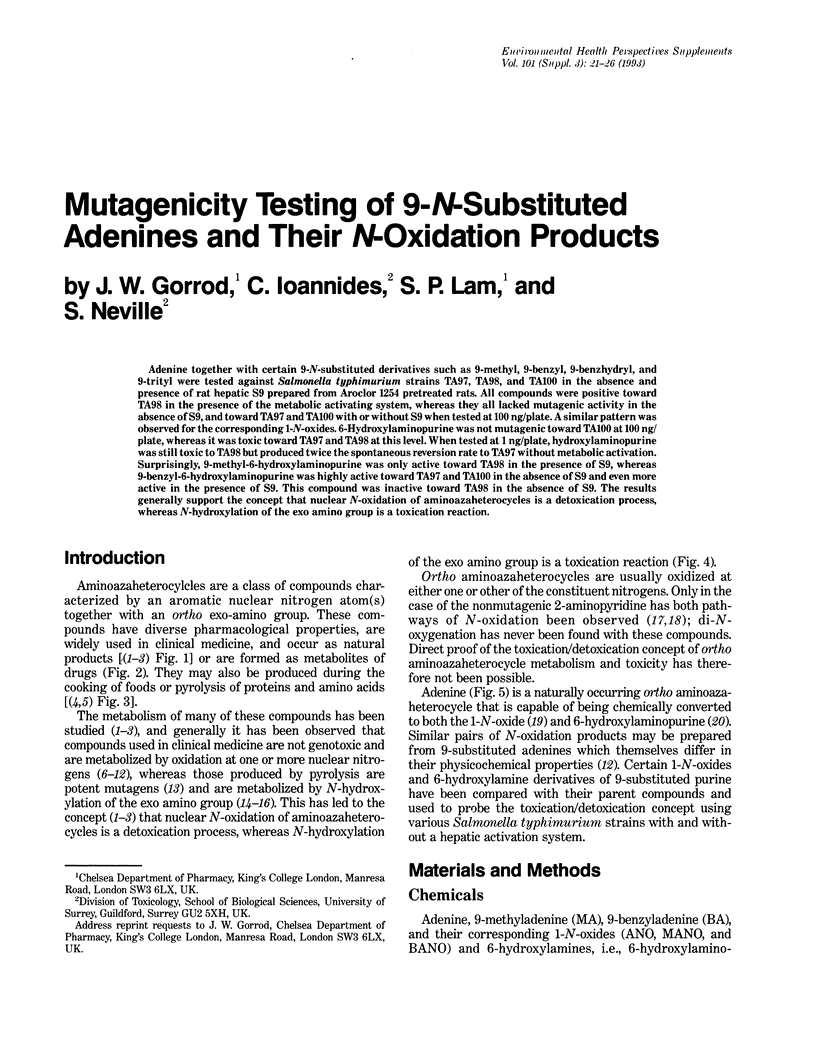
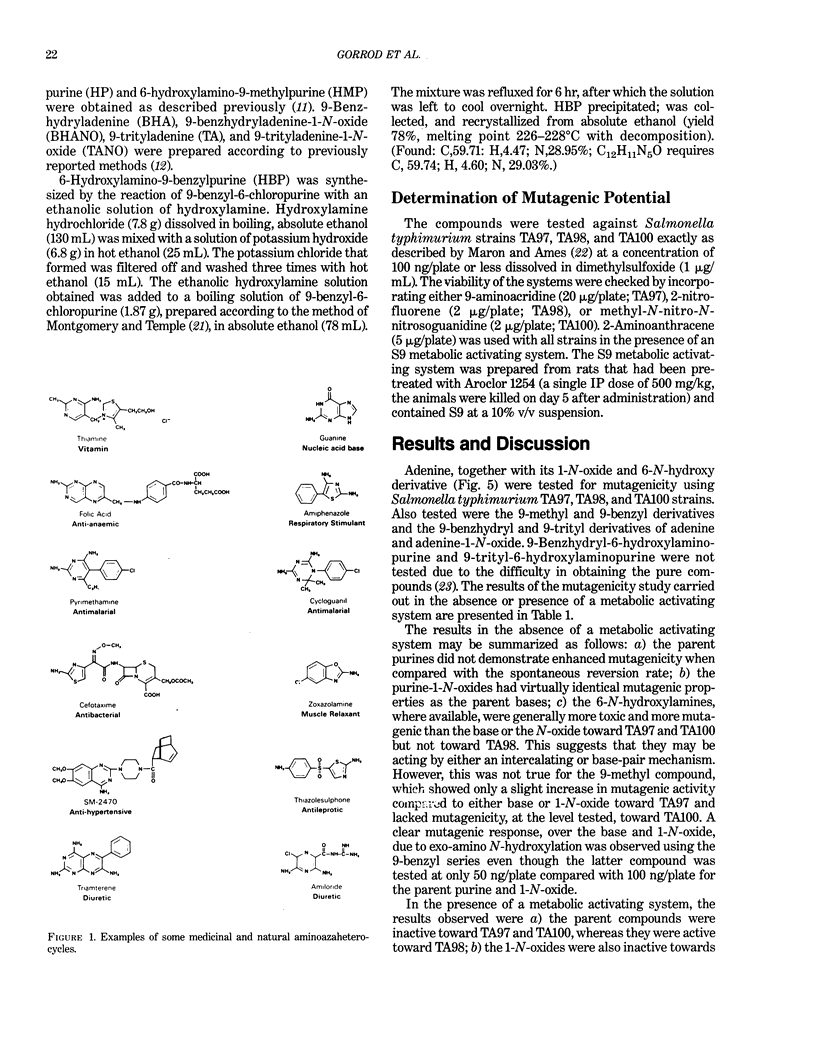
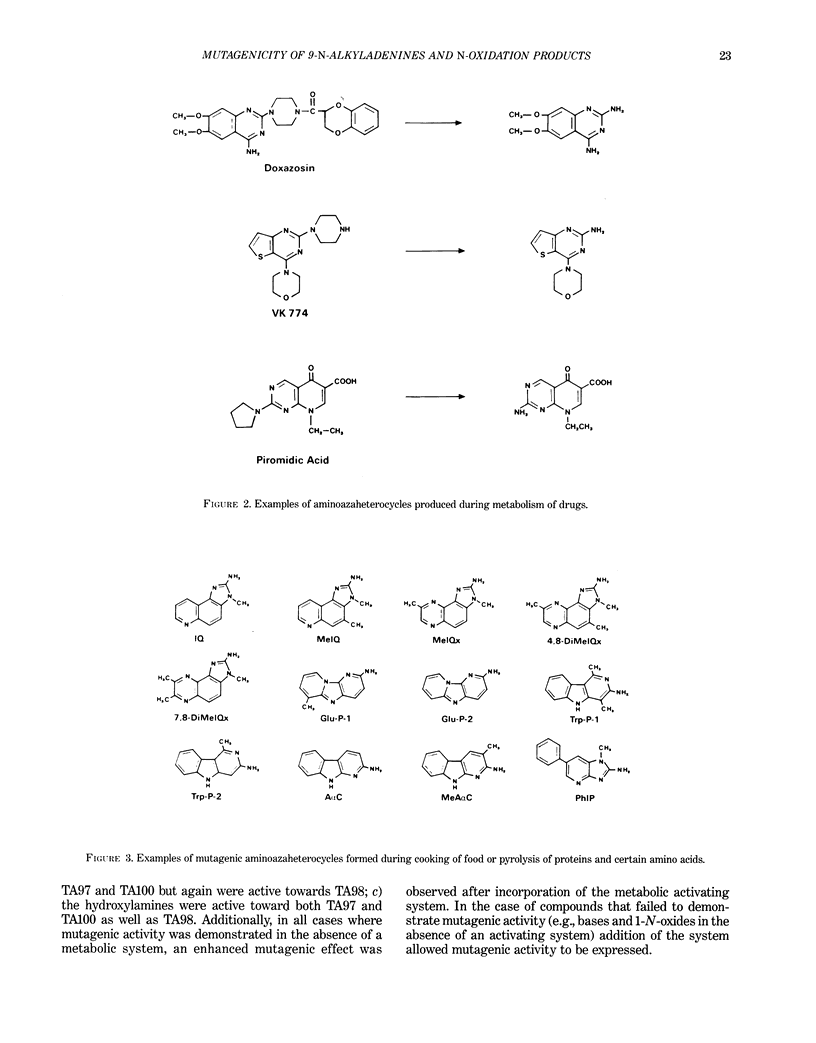
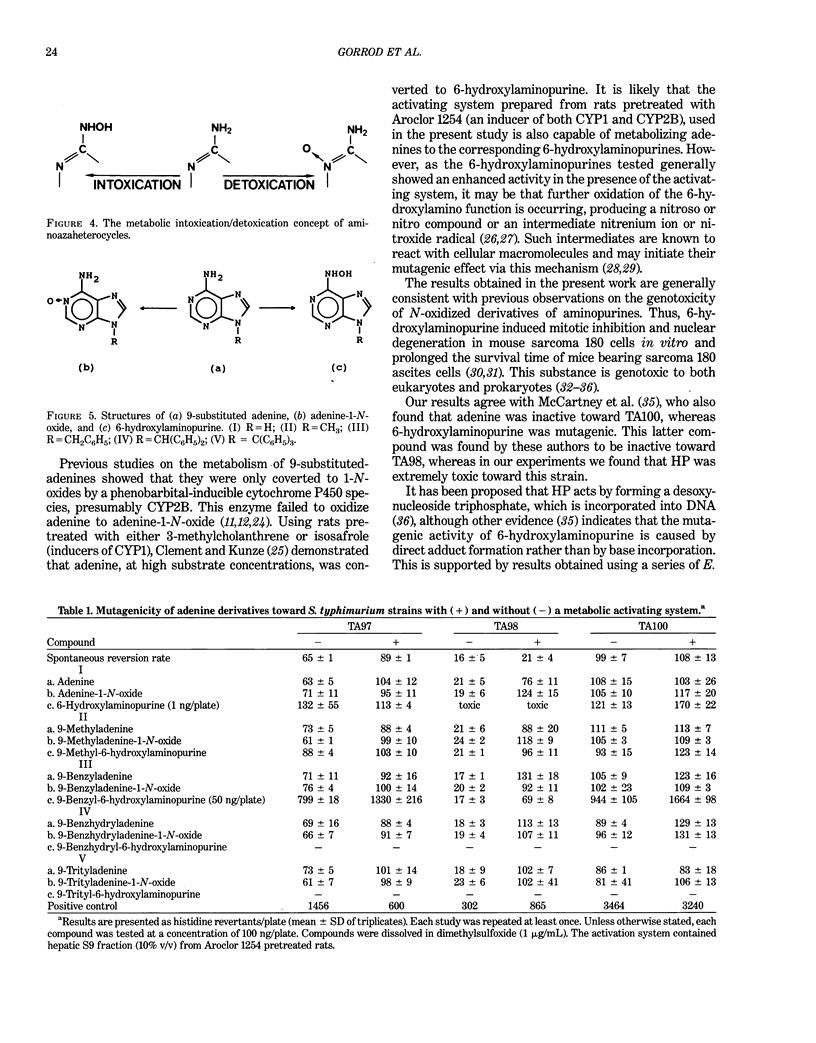
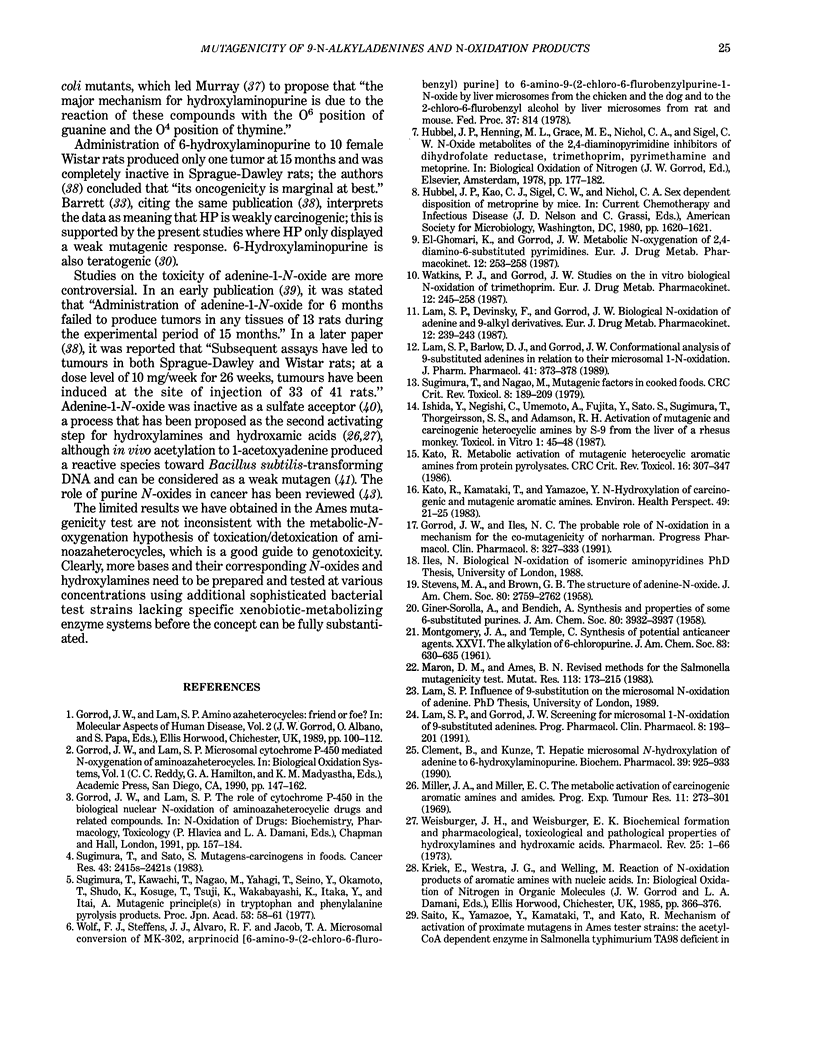
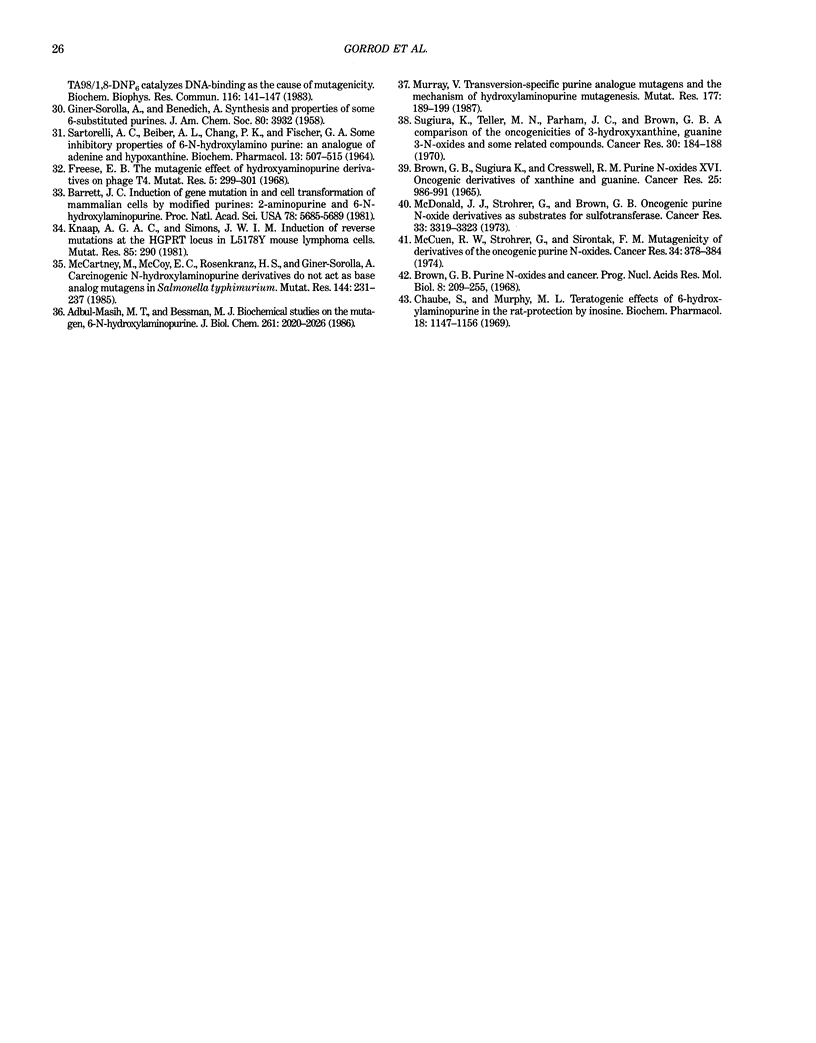
Selected References
These references are in PubMed. This may not be the complete list of references from this article.
- Abdul-Masih M. T., Bessman M. J. Biochemical studies on the mutagen, 6-N-hydroxylaminopurine. Synthesis of the deoxynucleoside triphosphate and its incorporation into DNA in vitro. J Biol Chem. 1986 Feb 15;261(5):2020–2026. [PubMed] [Google Scholar]
- Barrett J. C. Induction of gene mutation in and cell transformation of mammalian cells by modified purines: 2-aminopurine and 6-N-hydroxylaminopurine. Proc Natl Acad Sci U S A. 1981 Sep;78(9):5685–5689. doi: 10.1073/pnas.78.9.5685. [DOI] [PMC free article] [PubMed] [Google Scholar]
- Brown G. B., Sugiura K., Cresswell R. M. Purine N-oxides. XVI. Oncogenic derivatives of xanthine and guanine. Cancer Res. 1965 Aug;25(7):986–991. [PubMed] [Google Scholar]
- Chaube S., Murphy M. L. Teratogenic effects of 6-hydroxylaminopurine in the rat--protection by inosine. Biochem Pharmacol. 1969 May;18(5):1147–1156. doi: 10.1016/0006-2952(69)90118-x. [DOI] [PubMed] [Google Scholar]
- Clement B., Kunze T. Hepatic microsomal N-hydroxylation of adenine to 6-N-hydroxylaminopurine. Biochem Pharmacol. 1990 Mar 1;39(5):925–933. doi: 10.1016/0006-2952(90)90209-4. [DOI] [PubMed] [Google Scholar]
- Freese E. B. The mutagenic effect of hydroxyaminopurine derivatives on phage T4. Mutat Res. 1968 Mar-Apr;5(2):299–301. doi: 10.1016/0027-5107(68)90028-6. [DOI] [PubMed] [Google Scholar]
- Kato R., Kamataki T., Yamazoe Y. N-hydroxylation of carcinogenic and mutagenic aromatic amines. Environ Health Perspect. 1983 Mar;49:21–25. doi: 10.1289/ehp.834921. [DOI] [PMC free article] [PubMed] [Google Scholar]
- Kato R. Metabolic activation of mutagenic heterocyclic aromatic amines from protein pyrolysates. Crit Rev Toxicol. 1986;16(4):307–348. doi: 10.3109/10408448609037466. [DOI] [PubMed] [Google Scholar]
- Lam S. P., Barlow D. J., Gorrod J. W. Conformational analysis of 9-substituted adenines in relation to their microsomal N1-oxidation. J Pharm Pharmacol. 1989 Jun;41(6):373–378. doi: 10.1111/j.2042-7158.1989.tb06480.x. [DOI] [PubMed] [Google Scholar]
- Lam S. P., Devinsky F., Gorrod J. W. Biological N-oxidation of adenine and 9-alkyl derivatives. Eur J Drug Metab Pharmacokinet. 1987 Oct-Dec;12(4):239–243. doi: 10.1007/BF03189906. [DOI] [PubMed] [Google Scholar]
- Maron D. M., Ames B. N. Revised methods for the Salmonella mutagenicity test. Mutat Res. 1983 May;113(3-4):173–215. doi: 10.1016/0165-1161(83)90010-9. [DOI] [PubMed] [Google Scholar]
- McCartney M., McCoy E. C., Rosenkranz H. S., Giner-Sorolla A. Carcinogenic N-hydroxylaminopurine derivatives do not act as base analog mutagens in Salmonella typhimurium. Mutat Res. 1985 Dec;144(4):231–237. doi: 10.1016/0165-7992(85)90056-9. [DOI] [PubMed] [Google Scholar]
- McCuen R. W., Stöhrer G., Sirotnak F. M. Mutagenicity of derivatives of the oncogenic purine N-oxides. Cancer Res. 1974 Feb;34(2):378–384. [PubMed] [Google Scholar]
- McDonald J. J., Stöhrer G., Brown G. B. Oncogenic purine N-oxide derivatives as substrates for sulfotransferase. Cancer Res. 1973 Dec;33(12):3319–3323. [PubMed] [Google Scholar]
- Miller J. A., Miller E. C. The metabolic activation of carcinogenic aromatic amines and amides. Prog Exp Tumor Res. 1969;11:273–301. doi: 10.1159/000391399. [DOI] [PubMed] [Google Scholar]
- Murray V. Transversion-specific purine analogue mutagens and the mechanism of hydroxylaminopurine mutagenesis. Mutat Res. 1987 Apr;177(2):189–199. doi: 10.1016/0027-5107(87)90002-9. [DOI] [PubMed] [Google Scholar]
- SARTORELLI A. C., BIEBER A. L., CHANG P. K., FISCHER G. A. SOME INHIBITORY PROPERTIES OF 6-N-HYDROXYLAMINOPURINE: AN ANALOG OF ADENINE AND HYPOXANTHINE. Biochem Pharmacol. 1964 Mar;13:507–515. doi: 10.1016/0006-2952(64)90171-6. [DOI] [PubMed] [Google Scholar]
- Sugimura T., Sato S. Mutagens-carcinogens in foods. Cancer Res. 1983 May;43(5 Suppl):2415s–2421s. [PubMed] [Google Scholar]
- Sugiura K., Teller M. N., Parham J. C., Brown G. B. A comparison of the oncogenicities of 3-hydroxyxanthine, guanine 3-N-oxide, and some related compounds. Cancer Res. 1970 Jan;30(1):184–188. [PubMed] [Google Scholar]
- Watkins P. J., Gorrod J. W. Studies on the in vitro biological N-oxidation of trimethoprim. Eur J Drug Metab Pharmacokinet. 1987 Oct-Dec;12(4):245–251. doi: 10.1007/BF03189907. [DOI] [PubMed] [Google Scholar]
- Weisburger J. H., Weisburger E. K. Biochemical formation and pharmacological, toxicological, and pathological properties of hydroxylamines and hydroxamic acids. Pharmacol Rev. 1973 Mar;25(1):1–66. [PubMed] [Google Scholar]
- el-Ghomari K., Gorrod J. W. Metabolic N-oxygenation of 2,4-diamino-6-substituted pyrimidines. Eur J Drug Metab Pharmacokinet. 1987 Oct-Dec;12(4):253–258. doi: 10.1007/BF03189908. [DOI] [PubMed] [Google Scholar]


